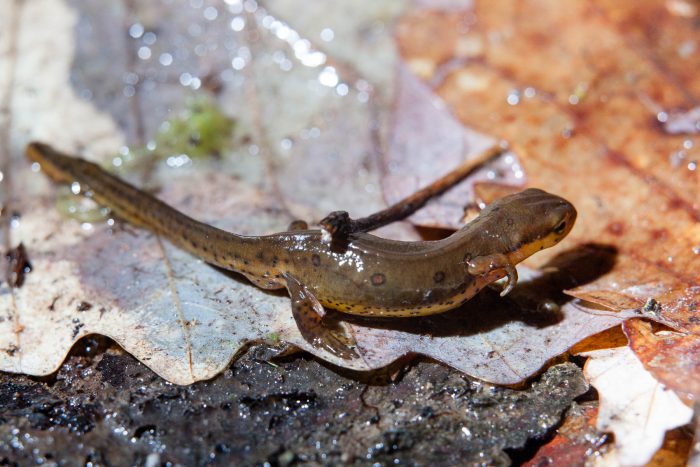Eastern Newt
Notophthalmus viridescens
With a complex life cycle, the eastern newt can be found in aquatic and terrestrial environments throughout the Chesapeake Bay watershed depending on the stage it is in.
This section shows one large critter image at a time. Use the thumbnails that follow to select a specific image to display here.

This gallery contains a grid of small thumbnails. Selecting a thumbnail will change the main image in the preceding section.
Appearance
In the larvae stage, an eastern newt has olive green and yellow colored skin, a thin tail and feather-like external gills. Eastern newts lose their gills and change color ranging from a bright orange or red to a duller brown when it reaches the juvenile stage.
The juvenile newt has coarse skin and does not have a tail fin that the eastern newt in its adult stage will have. In its adult stage, the eastern newt turns greenish-yellow again, returns to living in the water and has small black dots on its back with a row of small orange or red dots on either side of its back.
Feeding
In juvenile and adult stages, the eastern newt eats worms, insects, leeches, snails, small fish and eggs and larvae of salamanders and frogs.
Predators
Birds, fish and other amphibians are predators of the eastern newt, but the newt’s bright colored spots and skin in the juvenile stage deter predators. Their skin also has a neurotoxin that makes them unappealing to predators.
Reproduction and life cycle
Eastern newts breed in late winter and early spring. The female will lay between 200-350 jelly-covered eggs on submerged vegetation and the eggs will hatch in 3-5 weeks.
The eastern newt has three distinct phases after hatching starting with the larvae stage. In this stage, the eastern newt is completely aquatic and has distinct gills. In 2-5 months, the newt loses its gills and moves to a juvenile stage where it is called an eft.
The eft can be bright orange or a duller brown color and lives on land under leaf litter. They live in this stage for 2-3 years before moving to the adult stage. In the adult stage, the eastern newt becomes aquatic again. They can survive on land in the adult stage but normally live in the water. The adult eastern newt becomes greenish-yellow again and can live between 10 and 15 years.
Did you know?
- Some eastern newt populations skip the eft stage and move straight from larvae to adults. They keep their gills and do not ever live on land. This is called neoteny and is most likely to happen to coastal plains populations of the eastern newt. Other populations stay in the eft stage indefinitely and only enter the water to breed.
- Male eastern newts court females by wiggling their tails and emitting pheromones.
Sources and additional information
- Eastern Newt - Smithsonian’s National Zoo & Conservation Biology Institute
- Eastern Newt (Notophthalmus viridescens) - United States Geological Survey
- Species Spotlights: Eastern Newt - Maine Department of Inland Fisheries & Wildlife
